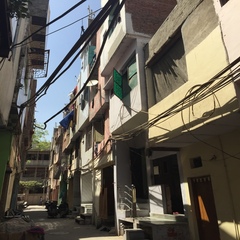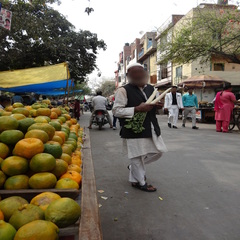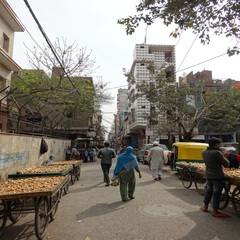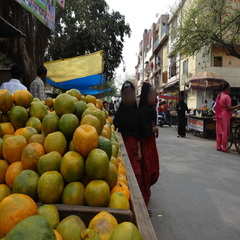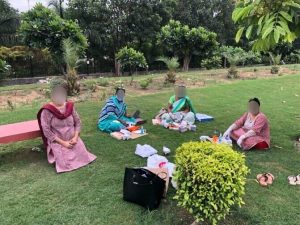City Research Team Lead
Researcher

Dr. Anindita Datta is Associate Professor at the Department of Geography, Delhi School of Economics, University of Delhi, and the Delhi CRT Lead Researcher. Her research interests are in the area of feminist geography, conceptual traditions in geography and social geography of India, particularly interested in geographies of care, indigenous feminisms, spaces of resistance, everyday geographies and in issues of gendered and epistemic violence. Dr. Datta is Chair of the Steering Committee, IGU Commission for Gender and Geography, and served on the international editorial board for Gender Place and Culture and Social and Cultural Geography. In this project she is interested in looking at feminist solidarities, resistances and resilience in the midst of constant precarity.

Swagata Basu is an Associate Professor and Head of the Department of Geography at SSV College, Hapur, India. Swagata’s research interests are in the area of Violence against Women (VAW) and Intimate Partner Violence (IPV) as well as issues related to women’s right to the city. Swagata works closely with women’s organisations associated with livelihood issues of women in low income urban neighbourhoods.
Delhi Neighbourhood
The Delhi CRT will base its study in a resettlement colony tucked away in the North Eastern part of the capital city where members of the weaver community were resettled.
The re-settlement of the urban working class from the central parts of the city to this locality began four decades ago, as a part of a scheme aimed at de-congesting the city. The initial stream of settlers recollect their impression about the area as nothing more than a huge stretch of wilderness, infested with insects and wild animals roaming free. The residents made make-shift hutments and struggled hard to get access to water and other basic amenities. With time, the working-class residents built small pucca brick houses and civic amenities were provided by the government. To meet the rising demand for cheap housing, the original tenements experienced a vertical growth, with more floors being built to accommodate migrants as tenants, and provide a rental income to the working class owners.
Today, bustling markets spill over the main road that leads to the colony; typists punch away on their typewriters for clients waiting to visit the nearby District Court, an aroma of fried food from crowded food stalls fills the air along with the cacophony of buyers, haggling over the prices of clothes, vegetables, fruits, utensils, sports goods and other items being vended on the roadside. There is hardly any greenery to be found in the colony, but for one or two tiny parks. The initial residents who settled in the colony now own the residential buildings and commercial spaces, while the subsequent streams of migrants who made the colony their home live in rented accommodations and commute to their workspaces, resulting in a diverse and gentrified community. The houses are mostly windowless and it is common to see women sitting outside their front doors, virtually on the kerbs during the day, while the men have left for work. The colony recently saw the mobilization of its residents for protests against the citizenship act, soon after which the neighborhood was also impacted by the communal riots that erupted over North East Delhi. The site is vibrant, dynamic and pulsating with stories of both resistance and resilience, as the lives of its people are now impacted by a new precarity- the spread of Covid -19.
दिल्ली शहर शोध दल
दिल्ली शहर शोध दल ने, अपने अध्ययन का क्षेत्र राजधानी दिल्ली के उत्तर पूर्वी हिस्से में स्थित एक पुनर्वास कॉलोनी को चुना, जहां बुनकर समुदाय के सदस्यों को चार दशक पहले पुनर्स्थापित किया गया था। शहर के केंद्रीय भागों में भीड़-भाड़ कम करने के उद्देश्य से एक योजना के रूप में, इस इलाके में शहरी श्रमिक वर्ग का पुन: बसावट शुरू हुआ था।
इस मोहल्ले में शूरु से रहने वाले लोग याद करते है कि, यह इलाका उस समय जंगल से घेरा क्षेत्र था और कीड़ों और जंगली जानवरों से इलाकावासी परेशान रहते थे। निवासियों ने उस बंजर भूमि पर अस्थायी झोपड़ियाँ बनाईं, साथ ही साथ पानी और अन्य दैनिक सुविधाओं को प्राप्त करने के लिए कड़ी मेहनत की। कुछ वर्षों के उपरांत, श्रमिक वर्ग के निवासियों ने छोटे-छोटे पक्के ईंट के घर बनाए और सरकार द्वारा मोहल्ले में रहने वालों को बिजली और पानी की सुविधाएं प्रदान की गईं। समय के साथ-साथ, मोहोल्ले की आबादी बढ़ती गई और सस्ते आवास की बढ़ती मांग को पूरा करने के लिए, मूल मकानों में दूसरी तथा तीसरी मंज़िलें निर्माण की गयी। जिन श्रमिकों ने बाद में आकर इस मोहल्लें में बसे, वे किरायेदारों के रूप में रहने लगे। इस प्रकार पहले से बसे लोगों को माकन का किराया से आय मिलने लगे।
आज, कॉलोनी की ओर जाने वाली मुख्य सड़क पर एक अतिव्यस्त बाज़ार फैले हुए हैं। बाज़ार में कपड़े, सब्जियां, फल, बर्तन, खेल के सामान की कीमतों पर मोलभाव की आवाज़ पूरे सड़कों पर गूंजती हैं, भीड़ भरे खाद्य स्टालों से तले हुए भोजन की सुगंध हवा में फैल जाती है और पास के जिला न्यायालय में जाने के लिए इंतजार कर रहे ग्राहकों के लिए टाइपिस्ट अपने टाइपराइटर पर तेज़ी से टाइपिंग करते हुए देखने को मिलते हैं। कॉलोनी में हरियाली बहुत कम नज़र आती हैं, सिवाए एक या दो छोटे पार्क को छोड़कर। कॉलोनी में बसने वाले प्रारंभिक निवासी अब आवासीय भवनों और वाणिज्यिक स्थानों के मालिक बन गए हैं, जबकि बाद के बसे हुए निवासी, किराए के मकानों में रहते हैं और अपने कार्यस्थलों पर बस से आते-जाते हैं, जिसके परिणामस्वरूप एक विविध समुदाय का निर्माण हुआ है। मोहल्ले में घर ज्यादातर खिड़की रहित होते हैं और दिन के दौरान जब पुरुष काम पर चले गए होते हैं, महिलाएं घर के काम करने के उपरांत, घर के सामने के दरवाजे
के बाहर बैठे हुए नज़र आते हैं।हाल ही में, यह मोहोल्ला उत्तर पूर्वी दिल्ली में घटित सांप्रदायिक दंगों से भी प्रभावित हुआ। इस कॉलोनी की महिलाएँ शहरी असमानताओं के भीतर जीवनयापन करने का नियत प्रयास करती हैं, वे अपने अधिकारों के लिए लड़ते हैं, लेकिन सबसे बढ़कर उनका योगदान यही है की वे अपने मूल स्थान से दूर, एक शहरी मोहल्ले में प्यार और सौहार्द से रहते हैं जो कोविड 19 महामारी के दौरान स्पष्ट हो गया जब यहां रहने वाले सभी लोग अनिश्चितताओं और भय से घिरे हुए थे।


